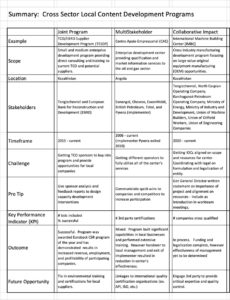The oil and gas (O&G) industry is well-positioned to serve as an engine of growth for employment and manufacturing in domestic economies. By utilizing demand stemming from the development of oil and gas fields, national and regional economies should be able to reap significant manufacturing and workforce localization benefits. While the fundamentals for success are in place in many transitioning and frontier markets, and many governments, private sector, and NGO actors prioritize local content development, a long-term sustainable solution continues to be an elusive goal. In this paper, we will examine the current context, identify factors that block progress in local content, discuss existing models for cross-sectoral collaboration, and highlight key considerations in the design of local content programming.
While International Oil and Gas Companies (IOC) are the key players in this sphere, there are additional stakeholders with power and influence in the industry whose actions can contribute to impactful localization. Understanding the strengths and weaknesses of these organizations is critical to designing appropriate roles for each in local content programming:
- National & Regional Governments and Ministries (Government): Elected personnel or appointed ministers responsible for regulating O&G industry (Example: President, Minister of Energy, Governor). While these bodies have significant leverage over the industry, they often lack the knowledge and funding to drive large-scale localization initiatives. Additionally, while governments understand the business and operational issues encountered by IOCs their strategic goals are not always aligned.
- International Oil Companies (IOCs): Large, multinational companies who purchase concessions from government authorities to develop the oil and gas reserves (Example: Chevron, ExxonMobil, Total). IOCs have tremendous technical knowledge and broad purchasing power, but lack insights and capacity to analyze, design, and implement impactful local content initiatives.
- Service and Manufacturing Associations (Industry): Non-profit associations or chambers of commerce responsible for promoting business or specific sectors to government or market at large (Example: Chambers of Commerce, Oilfield Service Provider Association). Industry associations have strong links to business but lack the resources, capabilities, and capacity to drive large-scale economic development initiatives.
- Tier One Suppliers (Suppliers): Large global suppliers who provide complex or end-to-end solutions to IOCs for the exploration or operation of O&G fields (Example: Schlumberger). While they have tremendous capabilities, these companies are mainly transactional and look to the IOCs for direction on how to approach local content investment.
- Localization Consultants and Implementers (Implementers): NGOs or firms with technical and strategic expertise in the analysis and implementation of localization projects. (Example: Deloitte, DAI, Resonance). Implementers have good capacity, experience, capabilities, and strong monitoring and evaluation programs; but lack the resources to be able to implement programs on their own.
Constraints to O&G Localization
Local Content is Just One of Many Strategic Priorities for the Industry: Localization has the potential to provide significant business value through localization of workforce and manufacturing. However, there are several decision-making criteria which are impacted by changing from proven, global suppliers: cost, delivery, quality, and safety. As schedules become tighter, cost pressures reduce profits, and IOCs exploit deeper more complex reservoirs, there is a disincentive to switching suppliers, especially to “unproven” local ones without significant commercial or technical advantages.
O&G Fields have Stringent Standards for Provision of Goods and Services: Many international O&G concessions (fields) are won and operated by IOCs which bring world-class expertise and technologies to their development and operation. These complex solutions often require suppliers and business partners which have proven safe and cost-effective solutions not found outside a few global centers of excellence. Meaning there is a relatively small global group of subject matter experts who can design, implement, and maintain these systems. And finally, from a goods and material standpoint the quality, capabilities, and specifications mean that goods that are manufactured in global centers of excellence whose global distribution provides the volume, supporting technologies, and expertise required will have significant advantages.
IOCs and Key Suppliers Lack Strategic Sustainability and Localization Expertise: IOCs and their suppliers often do not have the skillset internally to analyze and implement long-term sustainability projects outside their core business. While many IOCs have centers of excellence that understand and work on these issues globally, they generally lack the economic development, supply chain, strategic planning, and influencing skills to design and implement significant local content programs. Additionally, from the center they find it difficult to get their country-based IOC business units to look beyond the short-term tactical programs.
Disincentives for IOCs to Collaborate Meaningfully with Competitors: IOCs do not have strong drivers to collaborate with their competitors in a global or regional setting. All are consistently working to burnish their reputation vis-à-vis their competitors to improve their social license to operate and be more attractive partners for further concessions. Additionally, IOCs must navigate local, national, and global anti-trust issues which not only increase the work to execute a cross-industry partnership but also involve substantial legal and compliance review and input to move forward. These factors act against the desire to collaborate meaningfully across the O&G sector.
Transactional, Short-Term Focus Leads to Sub-Optimal Outcomes: IOCs are large, complex, and risk-averse organizations. So outside of core business projects, such as drilling programs, this leads to conservative choices with a short-term focus. In the case of localization, IOCs and their suppliers were not traditionally responsible for the economic development of the countries and communities in which they operate. IOCs have neither the business drivers nor acumen to take on this task alone, and it is outside of their core operations and interests. Therefore, conservative choices with a short-term focus manifest themselves primarily as a focus on meeting compliance requirements from local and national governments (ex. “Total Spend with National Suppliers” or “Total % of Spend with Local/National Suppliers”), and focusing on reputational projects, and communicating results to influence key stakeholders.
As a result of this compliance and reputational focus, IOCs and their suppliers tend to make short-sighted decisions. This is exacerbated by governmental pressure to make large, visible investments in the workforce and manufacturing capacity to demonstrate economic progress. The resulting investments often neither improve the competitiveness of the local economy nor are sustainable and are thus generally short-lived. As an example, in Kazakhstan, oil country tubular goods (OCTG) producer Tenaris at the request of Tengizchevroil invested millions of dollars into a state-of-the-art pipe threading facility which never achieved 50% capacity of production.
Models for Cross-Sector Collaboration
Based on this context, it is evident that there needs to be a different approach to leveraging oil and gas operations to drive national and local economic development. When there are complex situations and relationships, and diverse stakeholders who are aligned on the desired outcome of increased economic development, the logical next step is to form cross-sector collaborative partnerships. These partnerships can leverage diverse stakeholder strengths to increase scope, capabilities, and bring the resource mix necessary to tackle localization in a comprehensive and integrated manner. The following resource mix is critical to the creation of successful cross-sector collaborative projects:
- Government: Incentive, pressure, and permission for the O&G industry to pursue large scale, sustainable economic development programs.
- IOCs: Bring the demand, technical knowledge, and decision-making authority to localize goods and services.
- Associations: Provide market information and a communication conduit to the local market.
- Implementers: Provide the expertise and staffing to design, facilitate, and implement large scale programs on behalf of the operators.
These four stakeholder groups, when aligned, can develop, and implement significant domestic and regional economic initiatives, which can drive localization and improve economic outcomes for the country and communities which own the resources. The Resonance guide to cross functional partnerships offers a lens for understanding the various types of partnerships: program, multi-stakeholder, and collaborative impact. These are all highly relevant to the O&G industry, each with its own challenges, opportunities, and best practices depending on the opportunity, stakeholders, and scope. Before providing recommendations on which types of partnerships to focus on it is useful to look at a real-world example of each in the O&G context:
Joint Cross Sectoral Program: TCO/EBRD Supplier Development Program (TESDP): TESDP was launched in 2015 as a small and medium enterprise development program providing direct consulting and training to current and potential local suppliers for Tengizchevroil (TCO). TCO is operating in Kazakhstan and the program implemented by the European Bank for Reconstruction and Development (EBRD). One of the key challenges to implementation was getting internal stakeholders to recognize the value of the services and engage the program. This was overcome by aligning TCO management and increasing internal communications of success stories. The two partners have developed a good working relationship through access to opportunities and demonstrated successes. The program has demonstrated significant increases in employment and revenue for participating companies and was awarded the corporate social responsibility (CSR) project of the year in 2018.
Multistakeholder Program: Centro de Apoio Empressarial (CAE): Since 2006, CAE has been providing supplier development services to the oil and gas sector in Angola. Its stakeholders are Sonangol, Chevron, ExxonMobil, British Petroleum, and Total. Originally implemented by Pyxera, CAE was handed over to local management under the direction of Sonangol at the end of 2012. An initial challenge was to get the different IOCs to buy into the program and utilize its services. This was partially overcome by identifying quick wins and communicating these to the IOCs, highlighting the benefits of using the center. While this helped, the level of engagement by different stakeholders was mixed.
Collaborative Impact Program: International Machine Building Center (IMBC): IMBC is a cross-industry manufacturing development and industrialization project in Kazakhstan which is championed by the Minister of Energy and with funding from the three largest IOCs (Tengizchevroil, North Caspian Operating Company, and Karachaganak Petroleum Operating Company). The planning and design were performed in the fourth quarter of 2020 with legalization in April 2021. One of the main challenges of the ideation process was getting the different parties aligned on the resources and service model. A key tool to drive alignment was to have a written statement from the three IOC General Directors on the desired outcome and their support. This helped align the local content, technical, and legal teams to get the project completed.
Recommendations
Many activities can improve the localization of goods or the nationalization of services in the oil and gas sector. However, to move beyond incremental progress, stakeholders must think big – and the best way to accomplish this is to have a specific employment-generating Collaborative Impact Program with significant contributions from all stakeholders. This will require IOCs to buy into the program and do business differently. Governments will need to make strategic investments and have some “skin in the game”. Critically, an experienced, trusted implementer must be selected who can facilitate and execute the program in a transparent and ethical manner.
The following recommendations to stakeholders will improve the effectiveness of cross-sectoral programming, regardless of selected mode:
- Governments: Collaborate and align with all stakeholders to identify key opportunities to champion. Once selected, provide incentives and pressure to complete. Also provide all necessary legal, compliance, and anti-trust clearances for the parties to work together.
- International Oil Companies: Engage internal global centers of excellence to provide guidance and best practices for engaging cross-industry initiatives. Ensure that there are significant controls and transparency measures in place to increase trust and effectiveness of initiatives.
- Associations: Work with IOCs and Government to identify competitive or potentially competitive domestic industries to develop. Ensure transparency and compliance in sharing information and opportunities.
- Implementers: Ensure that there is a clear vision articulated and recorded by the governmental and O&G leadership. This will be important for engaging different groups and getting their buy-in and contributions during the process.
In summary, to engage in large, impactful, sustainable programs requires multiple stakeholders to align and partner to bring the full weight of their capabilities to bear on complex challenges. If done collaboratively, transparently, and with strategic intent, programs can be implemented effectively, and results delivered to local communities and their populations.
Appendix 1: Summary of Cross-Sector Programs


